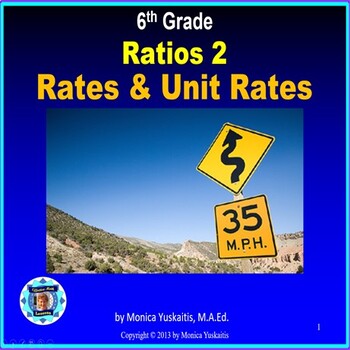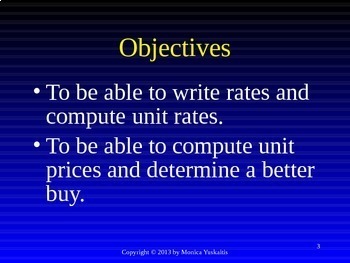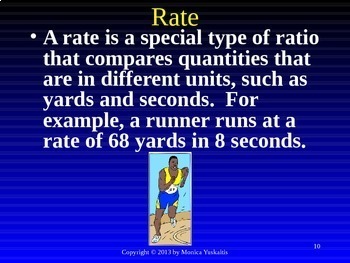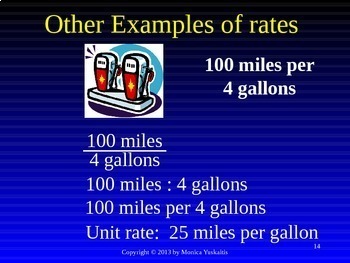6th Grade Ratio 2 - Rates & Unit Rates Powerpoint Lesson
- PPTX
Also included in
- Sixth Grade Ratios and Proportions Bundle - It is made up of 5 separate Powerpoint lessons on the following topics: 1 - Introduction to Ratios, 2 - Rates and Unit Rates, 3 - Finding Ratios, 4 - Plotting ratios on the coordinate plane, 5 - Solving Proportion Problems. For more information on eachPrice $15.00Original Price $18.75Save $3.75
- Sixth Grade Powerpoint Math Bundle is composed of 58 different high quality math powerpoint lessons comprising 2,923 slides. These are perfect for distance learning on Zoom or similar formats. On top of that they are powerful when used as direct instruction in the classroom.There are 22 strategiesPrice $149.63Original Price $213.75Save $64.12
Description
Sixth Grade Ratio 2 - Rates and Unit Rates - This is perfect for distance learning on Zoom or similar formats. On top of that it is powerful when used as direct instruction in the classroom. It teaches students how to use rates to solve problems. Students learn how to find the unit rate and use that rate to comparison shop. In addition students learn how to draw and use a double number line diagram to solve rate problems. There are 22 effective teaching strategies based on research used in this lesson. For best results, students should have white boards and dry erase markers. For instructions on how to successfully use this powerpoint math lesson click here. For a list of the research used in preparing this lesson click here. Included in this powerpoint lesson are the following:
- title slide
- focus slide
- objectives
- Students will be able to write rates and compute unit rates.
- Students will be able to compute unit prices and determine a better buy.
- essential question
- What is a rate and unit rate in ratios and how can they help me solve problems?
- vocabulary
- concept development
- step-by-step demonstrations on how to write rates, compute unit rates, and compute unit prices
- problem solving with word problem
- reward slide
Be sure to follow my store to be alerted of new products. The first 48 hours is always 50% off. CLICK HERE
Don't forget to leave feedback on this lesson to earn points for purchasing other TpT products.
You may be interested in the following related powerpoint lesson:
Link - 6th Grade Ratios 1 - Introduction to Ratios
Link - 6th Grade Ratios 3 - Finding Ratios
Link - 6th Grade Ratios 4 - Plotting Ratios on the Coordinate Plane







